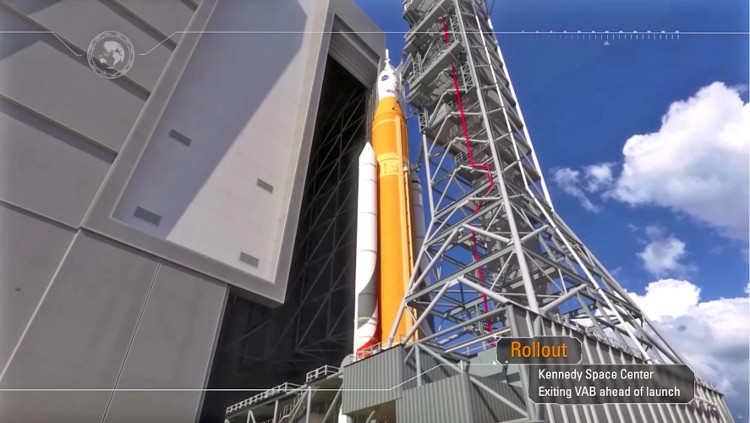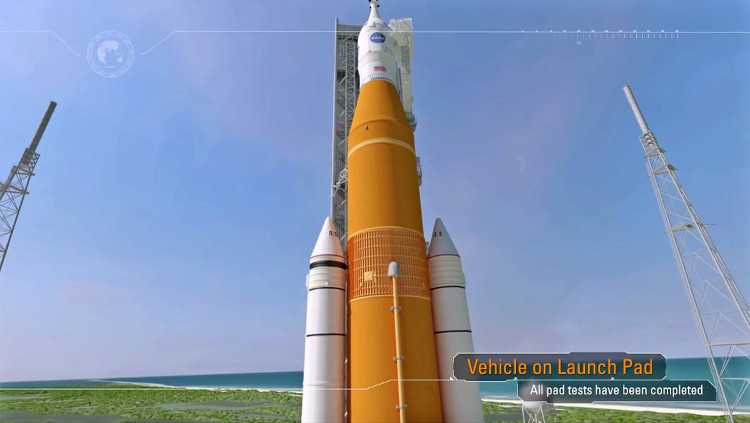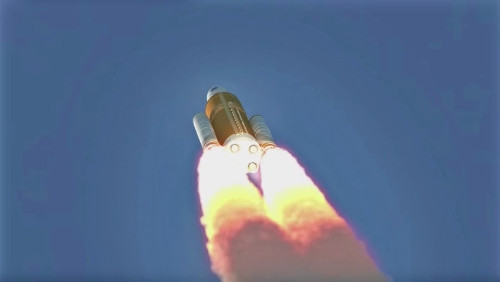NASA revealed the whole mission mission 22.5 days back to the Moon
NASA is ready to bring people back to the Moon after more than 45 years. This mission is expected to begin in 2019 with the most advanced technologies.
NASA recently announced highlights in the 25.5-day mission, including launch, take-off and landing on the Moon. Mission information is similar to Apollo flights in the 1960s and 1970s, but this flight will be more special, as this will be the farthest flight of manned missions ever.
In the near future, the agency will have a trial to bring the unmanned ship to Earth's low orbit called the Exploration Mission 1 (EM-1). If everything goes according to plan, the official mission to return to the Moon will be conducted with the Orion spacecraft and the latest SLS rocket propulsion system.

Orion missiles and spacecraft are installed in the launch pad.(Graphics: NASA).
Before the start of the EM-1 mission, the 32-story SLS missile system of a building carrying the Orion spacecraft will be located at the Kennedy Space Center - the location of the Apollo flights in the past. - to prepare to launch into space.

Technical inspection before launch time.(Graphics: NASA).
The engineers will have a few days to check, making sure the missiles are ready to launch. Many technical checks will be conducted to ensure the safety of the launch. The crew inside can also reach the outside of the ship with 90-meter-tall robotic arms.
One of the last steps for the ship to fly into space, is to refuel the cryogenic fuel (burning fuel at a low temperature). The amount of fuel is enough for the ship to fly off Earth and reach its final destination, the Moon.

The rocket began to rise into space to bring the ship into space.(Graphics: NASA).
Just before the rocket is launched, the power line and the connecting wires different from the ground station will be cut off. The main engine is prepared to burn fuel. Once the cryogenic fuel is burned and the temperature hits the specified level, the rocket will be launched. When flying, the rocket engine will produce a thrust of 4 million kg to counter 2.7 million kg of gravity.

Orion ships to Earth's low orbit.(Graphics: NASA).
The missile will reach its maximum pressure - the time when the atmosphere hits the rocket the most - just 90 seconds after it launches. It will leave rocket propellers after 2 minutes to reduce the load and let the Orion ship's solar panel be exposed. It will remove everything that belongs to the boosters after 3 minutes 40 seconds.
The ship's engine will stop working when the train reaches the correct speed with the original programmed level. After that, a temporary propulsion will work and the whole ship will be cooled down to low temperatures. At that time, Orion spacecraft will fly around the Earth to prepare for the journey to the Moon.
Orion will expand the solar panels, now it will gradually fly higher and then burn the fuel again to reach the intersection point of the Earth and Moon. The propellant from the burning fuel will take the ship to the point of this node and continue straight to the Moon.

After performing several revolutions around the Earth, the ship crossed the Van Allen radiation belt.(Graphics: NASA).
It will take about 4 days to fly to the Moon. During this time, the ship will reach many milestones. About 1.5 hours after launch, the Orion ship will pass through the Earth-Moon node and the ship will leave the propulsion stage. At this time, the ship went out of the 'net' of natural satellites orbiting the Earth and left
At this point, the ship entered the deep space outside the Earth but kept in touch with the ground station to prevent sudden changes in orbit before it made its way to the Moon.

Orion began to advance into the Moon's orbit.(Graphics: NASA).
When Orion ships closer to the Moon, it will start the engine based on the gravitational force of the Moon to enter the satellite's orbit. The ship will slow down, taking the initiative to be "captured" by the Moon's gravity.
The ship will approach the Moon the most at a distance of 100km and orbit this object with elliptical orbit for a week. At this distance, it will become a crew ship to the farthest point, beyond the International Space Station (ISS) 1,000 times with a distance of 435,000km.

Return to Earth.(Graphics: NASA).
When Orion was still flying in the Moon, the group was in charge of the return flight of the ship at the San Diego Naval Base that calculated the ship's landing position in the Pacific. At this time, the ground station will send a signal to the ship to burn the fuel again, the repulsive force that helps it leave the Moon orbit.
The journey back to Earth will take 4 days, the ship will head toward the Sun to cool the engine to the maximum. The engineers will calculate the ship to crash into Earth with the smallest angle.

Enter the Earth's atmosphere.(Graphics: NASA).
When the ship Orion comes close to Earth, it will remove the modules and key components for the flight. Controllers and cooling systems will begin to operate to control the flight direction for the entry into the Earth's atmosphere at a height of 122km.
The spacecraft will enter the atmosphere at a speed of 39,500km / h and travel 9 times slower than the actual gravitational force acting on a ship. On the outside, the temperature is as high as 2,800 degrees Celsius, but the control room inside is protected by a heat shield, so it is safe.

The crew cabin landed on the sea surface.(Graphics: NASA).
When the spacecraft flies out of the Earth's atmosphere, the US Navy engineer group in the Pacific will notice. After removing all the equipment and keeping only the module carrying the crew, the ship will sprung out and slowly land on the sea surface.
The ship will have 3 parachutes released to reduce speed. In 20 minutes, the Orion ship will slow down from 32 times the sound speed to 0. The naval ship will bring a small boat out to connect and pull Orion to the ship. Astronauts undergo medical checks, completing Orion's 25.5-day mission.
- The US revealed plans to re-conquer the Moon
- Scientists are angry because NASA canceled the mission to bring robots to the Moon
- The true message of the moon missions that NASA revealed in Orion video on Mars
- American astronauts confirm hearing the mysterious music on the Moon
- Astronauts have left piles of manure on the Moon and we will have to bring it back
- New NASA video confirms the Lunar outpost mission in 2024
- NASA revealed the time of the first immigration settlement on the Moon
- NASA extended the mission of Endeavor
- Back to the moon
- Testing the technology of the lunar exploration ship back to Earth
- NASA director revealed the first person to Mars
- All female crew tested moon mission
 Van Allen's belt and evidence that the Apollo 11 mission to the Moon was myth
Van Allen's belt and evidence that the Apollo 11 mission to the Moon was myth The levels of civilization in the universe (Kardashev scale)
The levels of civilization in the universe (Kardashev scale) Today Mars, the sun and the Earth are aligned
Today Mars, the sun and the Earth are aligned The Amazon owner announced a secret plan to build a space base for thousands of people
The Amazon owner announced a secret plan to build a space base for thousands of people